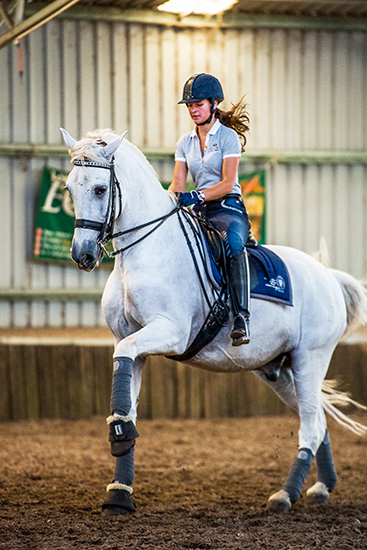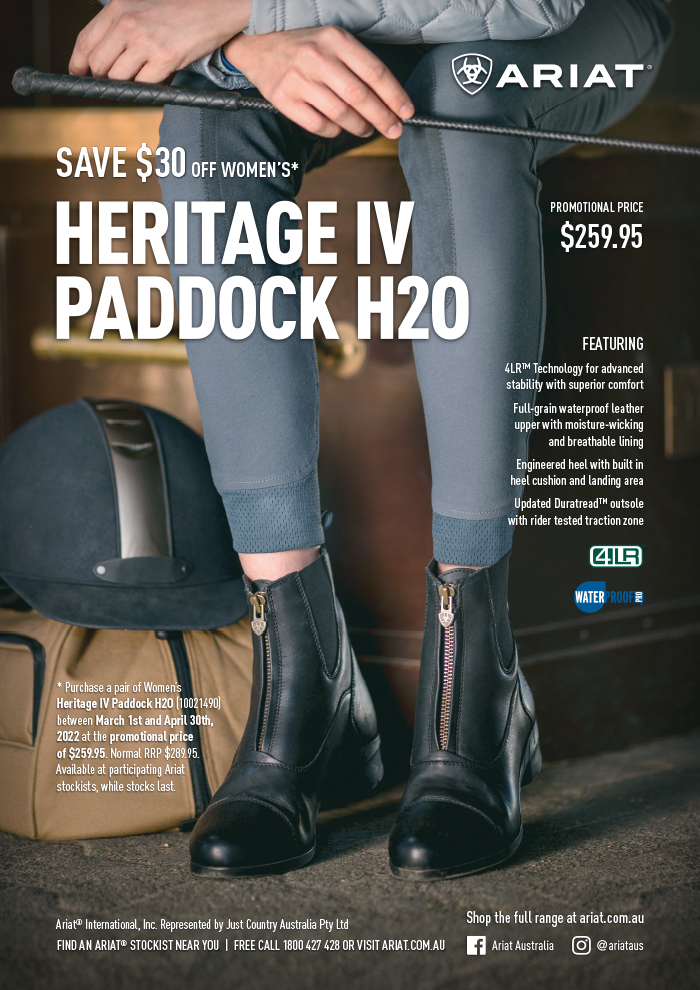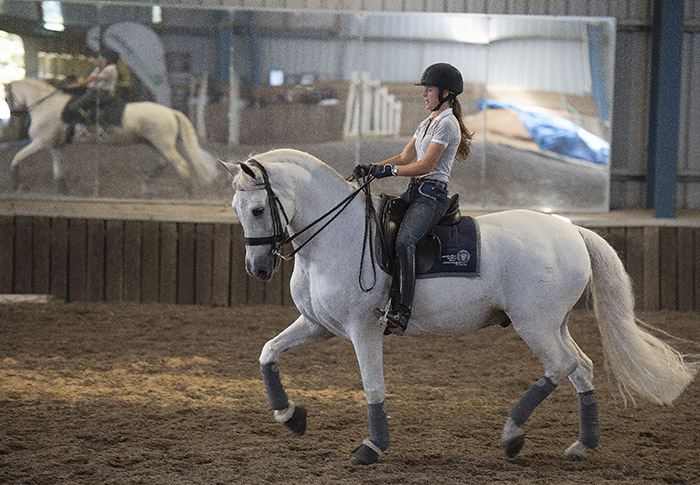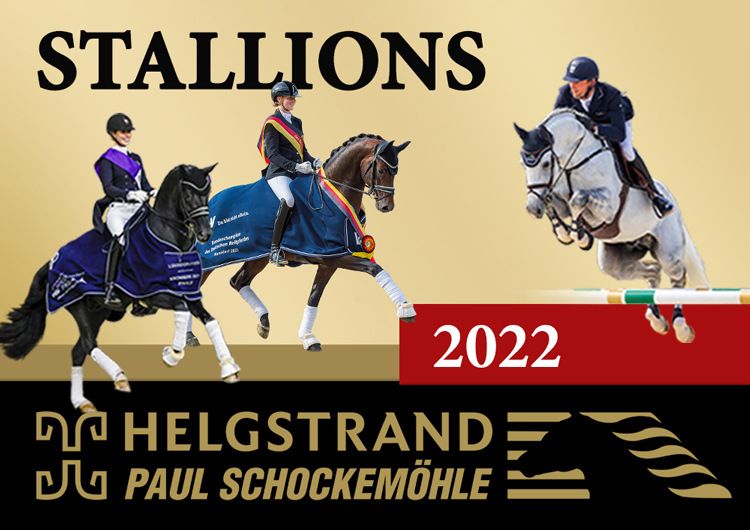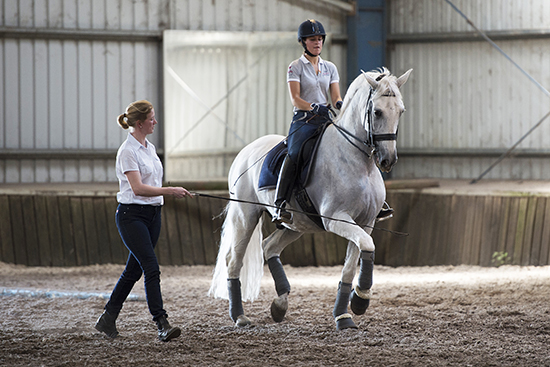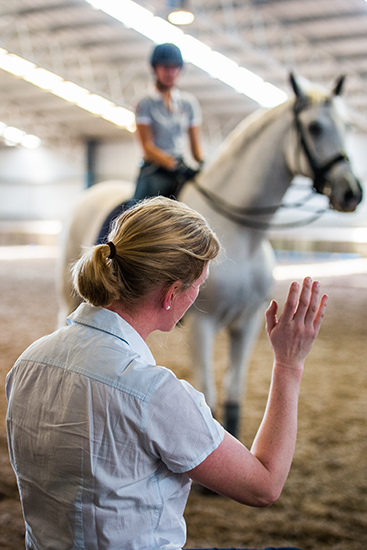 In this lesson with a young dressage rider, Lilah Nieuwland, Danish international and team coach, Princess Nathalie confronts the challenge of getting the rider to relax even when the horse is making that difficult to do…
In this lesson with a young dressage rider, Lilah Nieuwland, Danish international and team coach, Princess Nathalie confronts the challenge of getting the rider to relax even when the horse is making that difficult to do…
For her lesson with Princess Nathalie, Lilah brought Rangemore Mikardo, and she was quick to point out that while he might look like the ‘bombproof’ grey, he was in fact, quite difficult to ride:
“He is extremely sensitive. You can’t stress him or he gets very strong. I try to do the easier work at the beginning and keep him quiet.”
Nathalie was quick to pick up on the fact that this worry about keeping Mikardo quiet was affecting Lilah’s seat and her riding…
“You must relax your arms, and feel you can breathe right down to your stomach, so you really relax your upper body. Half halt then ride forward again, as much as he lets you before he gets strong again. Relax up on top when he gets tense, it’s not that you get scared, but RELAX, breathe deeply, let him know – relax.”
“We like it when they are sensitive but even when they are very sensitive, they have to listen more. Small half-halts so he waits for you. Even a sensitive horse has to accept that you can put your leg on and feel him on the side.”
Later, Nathalie talked about the difficulty of working with a brand new student:
“It is always difficult when you have a completely new rider with a new horse. I try to look into the whole picture, but mainly I was trying to get across to Lilah that half-halts are really, really important so she can actually give her hand again. It is especially important with a horse like that, where she says ‘oh he is very sensitive’ – it is even more important that she comes through with her aids, whether it is the half-halt or the going forward aid.”
Story continues below the advertisement
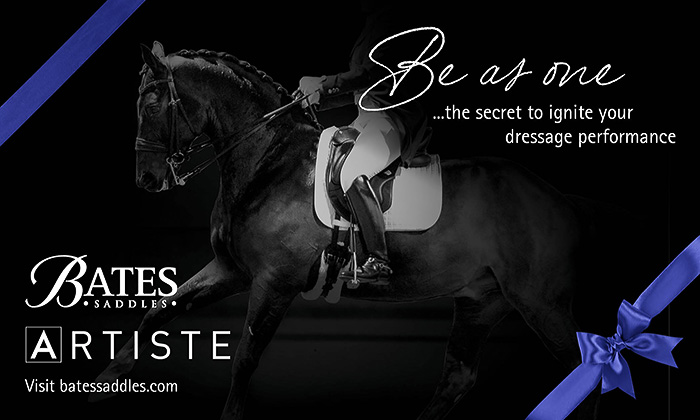
“With him, especially because he wants to run away a lot, he has to react to the half-halts. It is difficult to get through in one session, but maybe she has got a little bit the idea of what to work on.”
What you are saying is that you want simultaneously more and less, not sitting in the middle hoping everything will equalize?
“Exactly. She tries to sit there and hold on, she doesn’t really do anything to make it happen, or make a change. Maybe it is better once to make a harsher half-halt, but at least then you know – wow, he has reacted – then the next time, you can be very soft when you make your half-halt. Or when you come with the leg, maybe he will buck, or kick against the leg, but at least you’ve got a reaction. Just sitting there doing nothing is not good.”
Nathalie picked up the same problem in the canter work. Even in the changes, Lilah was getting Mikardo too backwards…
“In the changes, really think of keeping the rhythm. Push him forward from your seat. Not back and down, forward and up. You have to be able to let go in the ones. Have to be able to let go and he waits, or they get too short. Think, you want a nice big canter stride – he has to adjust to you,”
story continues below advertisement

It was the same working on the pirouettes, Lilah had to think about keeping the canter quicker:
“Keep the hind end active.”
But at the same time, keep cool.
“Think quiet from your body, let go of the reins. You can’t hold him there, he has to use his hind leg. Be aware of what is happening, it is not him turning, you say now you are allowed to turn. Use your leg and seat and let go of the hand. He has to have the chance to canter through his body – he has to listen to your seat. Let go of the hand, let go of the hand, let go of the hand… He’s strong in your hand because he is not really engaged from behind.”
It was interesting in the canter work, Lilah was either getting too flat and forward or too back and losing the canter – again, the task was to find somewhere in-between?
“It is again to dare to give. Yes, I am sure he is strong, and he just wants to canter long, and Lilah has found a way where she can just hold on to him, but she is actually riding back, and back, and back, and through that, losing more and more canter rhythm. She has to find the way where she can give on the rein, and he has to realise that he has to carry himself. He can’t use her hand as his fifth leg, he must not balance on her hand. She has to really make a half halt, let go and then he must realise, oh there is a hind leg that I have to stay on. I would try and get him entirely, completely off my hand, even if the head goes too far up, I would really make sure that he is off my hand, and make him realise that he has two hind legs that he has to stay on.”
It was time to work on the piaffe, and surprise, surprise, the message was much the same:
“Make him sensitive to your leg but soft in your hands. Play the rein like a harp so he doesn’t feel trapped. Play with your fingers and let yourself bounce in the saddle. You will get more elevation with light contact but you should feel that at any time you can push him forward.”
“In the passage, push up to passage. Use your whip on his croup and play with your fingers. Push him forward with your seat, so you feel he has to push off the ground with the hind feet.”
Story continues below the advertisement
Then it got a little interesting. Nathalie took a lunging whip and stood next to the horse in halt, and started tapping each leg in turn, first the hind legs, then the front legs, just asking the horse to bring the leg up in the air…
What were you trying to do when you were working on the ground with the lunging whip? When you were tapping each leg individually – just to get a reaction?
“To get a reaction, also that he learns to be able to stand on three legs. To lift one hind leg and keep it in the air, he has to balance and put the other hind leg in a spot where he can balance on three legs. I have it through Kyra, and Kyra has it through some American guy, but it really helps them get the idea of piaffing. Piaffing is really to keep the balance on two legs, but they first have to learn to be able to pick one leg up. With the front leg, it is the same. I’ve tried it with horses at home, they are not ‘stuck’ in their shoulder but it just gives them the idea of having to pick the front leg up, and if they have to pick the front leg up, they really have to sit down and take the weight on the hind legs, just to give them the idea, oh – there is actually a spot that I can stand on. It just makes them realise a little bit more what they can do with their body.”
So you just stand next to the horse?
“Stand next to them, then when they have learnt to pick one hind leg up, stand and hold it. Then you can try and get them to pick one leg up, then immediately, the next. Soon they will start piaffing. Go slowly along the wall with them in walk, asking them to lift their legs then suddenly, they start piaffing. It is quite interesting.”
This article first appeared in the June 2013 issue of THM.
Want to breed your own dressage star? International Horse Breeders have frozen semen from all the world’s great dressage lines. Check them out HERE

